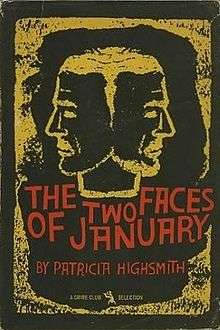The Two Faces of January
 First edition | |
| Author | Patricia Highsmith |
|---|---|
| Cover artist | Polly Cameron |
| Country | United States |
| Language | English language |
| Genre | Psychological thriller |
| Publisher | Doubleday |
Publication date | 1964 |
| OCLC | 16923778 |
| 813/.54 19 | |
| LC Class | PS3558.I366 T8 1988 |
The Two Faces of January (1964) is a psychological thriller novel by Patricia Highsmith. Its title alludes to the two faces of the Roman god Janus, after whom the month of January was named. Biographer Andrew Wilson, in his 2003 publication Beautiful Shadow: A Life of Patricia Highsmith claims the title is 'appropriate for the janus-faced, flux-like nature of her protagonists'.[1]
Plot outline
Chester MacFarland is an alcoholic con artist traveling in Greece with his young wife, Colette. McFarland is wanted by the police back in the U.S. for running a Ponzi scheme. In Athens, a Greek policeman questions McFarland, who accidentally kills him during a struggle in his hotel room. A recent acquaintance, a young American law graduate and poet named Rydal Keener, decides to help them, in part because McFarland reminds him of his recently deceased father, from whom he was estranged. He helps McFarland and Colette hide the body and leave Athens under false passports procured by his friend Niko, a local street vendor.
The trio take a flight to Crete and install themselves in a hotel under assumed names. Colette flirts with a smitten Keener in front of McFarland, whose jealousy eventually gets the better of him. On a rainy morning, while they visit the palace of Knossos, MacFarland tries to kill Keener by throwing a pithos at him from above, but accidentally kills Colette instead. Both MacFarland and Keener separately flee the scene undetected and take the same boat back to Athens, now more dependent on each other than ever.
Back in Athens, MacFarland is interviewed by the police, and states that Keener murdered Colette. At the same time, he hires a contract killer to get rid of Keener once and for all. He is unaware that the "hitman", whom he pays in advance, is in fact a florist whom Keener paid to set him up. Keener goes into hiding from the police, while MacFarland procures another false passport and books a flight to Paris.
In Paris, MacFarland learns from his accomplices in the Ponzi scheme that his enterprises in the USA are in the process of being exposed as fraudulent and that the American authorities may be looking for him. Nevertheless, he believes that going back to the States and starting afresh under a new name is the only option left to him. Keener, who McFarland had assumed was dead, suddenly reappears and blackmails him. Unbeknownst to McFarland, Keener is in fact working with the police to get him to confess to Colette's murder. Leaving behind all his possessions except his cash stuffed into his pockets, McFarland travels by taxi to Lyon and then on to Marseille, where he intends to get a boat or a plane to America. While waiting for the boat, however, he gets drunk in a bar and is mugged, robbed of everything except his overcoat. In his stupor, he is arrested and identified by the French police.
While in police custody, MacFarland gets hold of a guard's pistol, fires at him, and is shot in turn. As he dies, he takes responsibility for Colette's death, exonerating Keener. After the police clear Keener of any wrongdoing, he promises to go to McFarland's funeral service out of gratitude.
Reception
The London-based Crime Writers Association named The Two Faces of January the Best Crime Novel (foreign) for 1964.[2] Writing in the New York Times, Anthony Boucher called it "an offbeat, provocative and absorbing suspense novel".[3]
Adaptations
A film adaptation was released in 2014. It was written and directed by Hossein Amini, and starred Viggo Mortensen, Kirsten Dunst and Oscar Isaac.
References
- ↑ Wilson, Andrew (2003). Beautiful Shadow: A Life of Patricia Highsmith. London: Bloomsbury. p. 230.
- ↑ Boucher, Anthony (April 18, 1965). "Criminals at Large". New York Times. Retrieved December 12, 2015.
- ↑ Boucher, Anthony (August 2, 1964). "Criminals at Large". New York Times. Retrieved December 12, 2015.